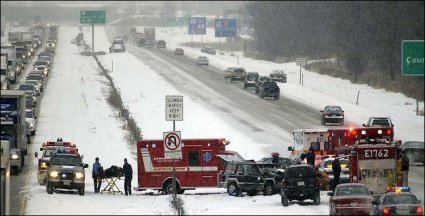Road Weather Predictions
Background
The U.S. economy depends on the national highway system. According to Weather and Highways: Report of a Policy Forum, developed by the Atmospheric Policy Program of the American Meteorological Society, more than 200 million cars and trucks use the national highway system, and about 77% (by weight) of domestic freight shipments are by truck (compared with other modes of transportation). Adverse weather, including rain, snow, sleet, and fog, can easily reduce roadway capacity and significantly affect the efficiency of this system.

Weather-related impacts on transportation networks (Image courtesy of the American Meteorological Society)
Weather also plays a critical role in highway safety. In the United States, adverse weather conditions cause 1.5 million vehicular accidents annually that result in approximately 800,000 injuries and 7,000 fatalities. In addition, snow, rain, fog, and ice impair roadway conditions to such an extent that well over 500 million hours are lost each year due to highway delays. The estimated annual economic cost from these weather-related crashes (deaths, injuries, and property) amounts to nearly $42 billion. Weather is a factor in about 28% of the total crashes and 19% of the total fatalities. It is clear that the societal and economic impacts of adverse weather on the highway system are huge.
The Role of High-Performance Computing
Advanced mesoscopic weather forecasting tools can provide specific weather information that is relevant for traffic planning and operations. Advanced microscopic traffic modeling capabilities, used together with such mesoscopic weather forecasting tools, can simulate the impact of changing weather conditions on the transportation system and help in the design of strategies that will both reduce the negative weather impact as well as improve the operation, maintenance, and design of the nation's roadways.
The amount and quality of off-the-shelf weather data and information have increased dramatically over the last decade. The National Weather Service modernization program has resulted in improved detection and prediction capabilities across the nation. Emerging technologies now exist to provide the impact of weather on a specific road segment based on objective calculation of the weather impact. Dedicated communication systems are no longer the only option in providing data to transportation managers and vehicle operators, making the delivery of weather information less expensive and more accessible. High-performance computing can help the transportation agencies to take advantage of these capabilities by integrating the weather related information into their operations and planning through detailed microscopic simulations of the traffic system response to current and expected weather condition changes.
For further information contact: This email address is being protected from spambots. You need JavaScript enabled to view it.